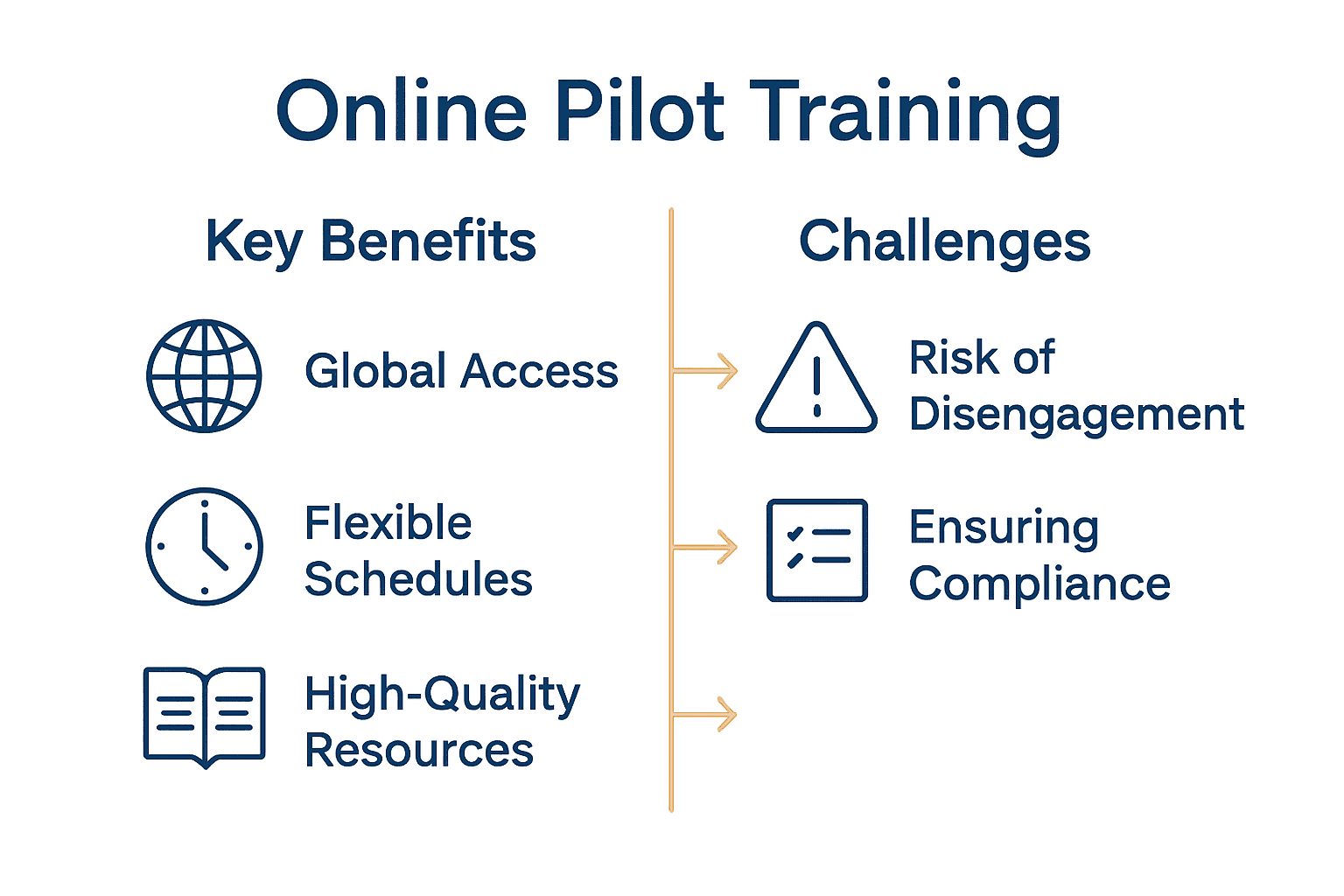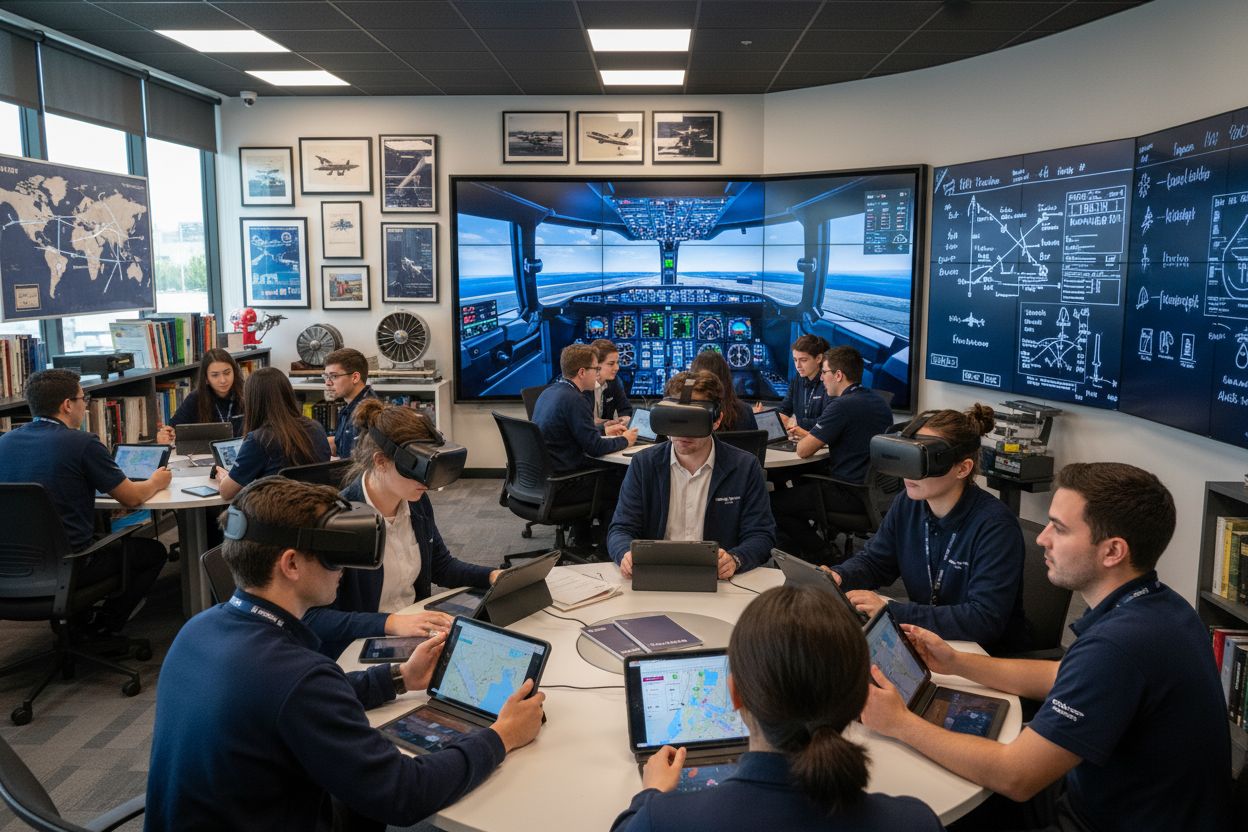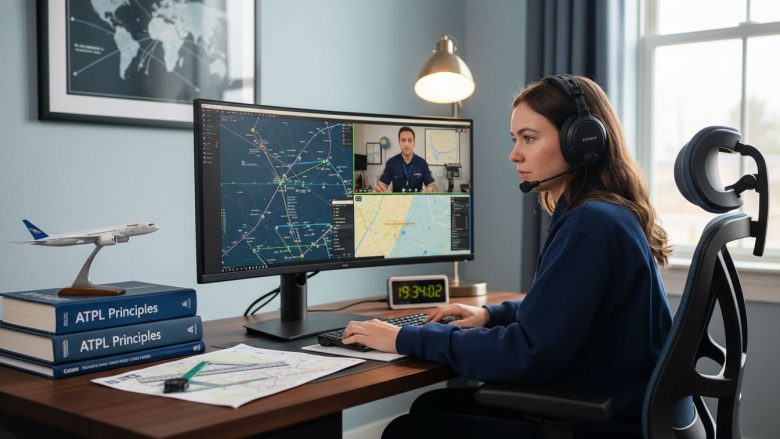Over 90 percent of pilot theory courses now include an online component, reshaping aviation education for both students and instructors. As airlines and training centers adapt to new technologies, flexible virtual classrooms are quickly replacing rigid schedules and crowded lecture halls. Today’s online learning options provide pilots with interactive experiences, high-quality resources, and direct instructor feedback that support deeper understanding while fitting busy, modern lifestyles.
Key Takeaways
| Point | Details |
|---|---|
| Virtual Learning Transformation | Online learning has fundamentally changed aviation training by enabling flexible, accessible theoretical education through various digital platforms. |
| Benefits and Challenges | While offering global access and high-quality resources, online training also faces issues like engagement and maintaining instructional quality. |
| Digital Tools Integration | Advanced technologies, such as VR simulations, enhance pilot training by providing realistic environments for skill practice. |
| Self-Discipline is Key | Successful online pilots prioritize structured study routines, proactive engagement, and effective time management to achieve training goals. |
Table of Contents
- Defining Online Learning In Aviation Training
- Key Benefits And Challenges For Pilot Students
- Essential Digital Tools And Learning Platforms
- Effective Self-Study And Time Management Strategies
- Common Pitfalls And How To Overcome Them
Defining Online Learning in Aviation Training
Online learning in aviation training represents a revolutionary approach to professional pilot education, transforming how theoretical knowledge is acquired and applied. Virtual classroom instruction has rapidly become a standard method for delivering comprehensive pilot training, enabling students to access high-quality educational content from anywhere in the world.
According to EASA guidance, virtual classroom instruction now supports critical training segments for aviation professionals, including:
- Initial pilot theoretical training
- Recurrent training programmes
- Continuing airworthiness education
- Air operations theoretical preparation
This digital transformation allows pilots to complete theoretical components of their training through flexible, interactive online platforms. Read more about the best online courses for aviation professionals to understand how technology is reshaping pilot education. The key advantage is the ability to maintain regulatory compliance while providing accessible, comprehensive training that fits modern learning preferences.
Modern online aviation training goes beyond simple video lectures. Interactive modules, real-time instructor consultations, digital question banks, and collaborative learning environments ensure that students receive a robust educational experience comparable to traditional classroom settings. By embracing these technological innovations, aspiring pilots can now pursue their professional goals with unprecedented flexibility and convenience.
Key Benefits and Challenges for Pilot Students
Online aviation training offers unprecedented opportunities for aspiring pilots, but it also presents unique challenges that require careful navigation. Digital learning environments have fundamentally transformed how pilot students acquire theoretical knowledge, presenting both remarkable advantages and potential obstacles.
According to EASA guidance, the key benefits of online pilot training include:
- Uninterrupted learning during global disruptions
- Flexible scheduling for working professionals
- Access to high-quality educational resources
- Consistent training standards across different providers
However, digital training is not without challenges. Maintaining student engagement, ensuring uniform training quality, and replicating the interactive aspects of traditional classroom learning remain significant considerations. Check out our essential tips for success in online ground school to help navigate these potential hurdles effectively.
The most successful online pilot students develop strong self-discipline, proactively engage with digital learning platforms, and create structured study routines. By understanding both the advantages and potential challenges of virtual aviation education, students can strategically approach their training to maximize learning outcomes and professional development.

Here’s a comparison of the main benefits and challenges of online aviation training:
| Aspect | Benefits | Challenges |
|---|---|---|
| Access | Global reach Flexible schedules |
Inconsistent quality Syllabus gaps |
| Learning Resources | High-quality materials Interactive tools |
Risk of disengagement Maintaining motivation |
| Regulatory | Consistent standards EASA compliant |
Ensuring compliance Varied provider quality |
| Student Experience | Professional development Convenient study |
Self-discipline required Less face-to-face contact |
Essential Digital Tools and Learning Platforms
Digital learning platforms have revolutionized pilot training, providing sophisticated tools that extend far beyond traditional classroom instruction. Modern aviation education now incorporates cutting-edge technologies that simulate complex flying scenarios with unprecedented realism and effectiveness.
EASA’s recent approval of Virtual Reality (VR) flight simulation technologies marks a significant milestone in pilot training. These advanced digital tools offer immersive learning experiences that enable pilots to:
- Practice high-risk manoeuvres safely
- Access cost-effective training environments
- Simulate complex flight scenarios
- Enhance skill acquisition without physical risk
Learn more about effective online collaboration for aviation professionals to understand how digital platforms are transforming professional development. Beyond VR simulators, comprehensive online learning platforms now integrate interactive modules, real-time instructor feedback, digital question banks, and collaborative study environments that provide a holistic approach to pilot education.
The future of aviation training lies in these intelligent, adaptive digital ecosystems. By combining high-fidelity virtual environments with expert-designed curriculum, these platforms ensure that aspiring pilots receive world-class theoretical preparation, regardless of their geographical location or personal constraints.

Effective Self-Study and Time Management Strategies
Online pilot training demands exceptional self-discipline and strategic time management skills that go beyond traditional learning approaches. Successful digital learners understand that virtual classrooms require proactive engagement and meticulously structured personal study routines.
According to EASA’s distance learning guidance, pilot students must develop structured theoretical programmes that align with virtual classroom sessions. This means creating a robust self-study strategy that includes:
- Dedicated daily study blocks
- Regular progress tracking
- Consistent review of regulatory content
- Systematic approach to online learning materials
Learn how to handle exam stress naturally and maintain your focus during intense study periods. Effective time management in online aviation training involves creating a balanced schedule that integrates live virtual sessions, independent study, practical exercises, and necessary personal breaks. The key is developing a personalised learning rhythm that maximises comprehension while preventing burnout.
The most successful online pilot students treat their digital learning environment with the same professionalism as a traditional classroom. This means establishing a dedicated study space, minimising distractions, setting clear learning objectives, and maintaining consistent communication with instructors and peers.
By approaching online education with structured discipline and strategic planning, aspiring pilots can transform digital learning platforms into powerful professional development tools.
Common Pitfalls and How to Overcome Them
Online aviation training presents unique challenges that can derail even the most motivated pilot students. Recognizing and proactively addressing these potential obstacles is crucial for successful digital learning and professional development.
EASA’s guidance warns of critical pitfalls in virtual classroom delivery, highlighting several key challenges pilots must navigate:
- Inconsistent training quality across providers
- Risk of reduced regulatory compliance
- Potential gaps in comprehensive syllabus coverage
- Challenges maintaining engagement in digital environments
Learn how to handle exam stress naturally and develop resilience against these common online learning challenges. Successful students overcome digital learning barriers by implementing strategic approaches such as maintaining regular communication with instructors, seeking additional resources when concepts seem unclear, and creating structured accountability mechanisms for their learning progress.
The most effective strategy for conquering online learning pitfalls involves adopting a proactive, disciplined approach. This means actively participating in virtual discussions, forming study groups with fellow online students, regularly self-assessing comprehension, and remaining committed to the highest standards of professional development, regardless of the learning platform’s format.
Ready to Transform Your Aviation Training Experience?
If you have felt held back by inconsistent online course quality, uncertainty about EASA compliance, or difficulty maintaining your motivation in digital classrooms, you are not alone. The challenges highlighted in this guide – from navigating self-study to mastering advanced digital platforms – can easily derail your progress as a pilot. With VictorOne.eu, these typical obstacles are addressed head-on. Our platform offers EASA-approved online theoretical courses, interactive learning materials, and live instructor support to help you bridge gaps in your training, stay engaged and meet professional standards with confidence.

Experience what quality online aviation education feels like. Whether you want to take your first step towards an ATPL(A) or ATPL(H)/IR course, prepare for ICAO English assessments, or explore tailored bridge programmes, VictorOne.eu is your proven route to career advancement. Do not let another day go by with uncertainty – visit VictorOne.eu now and secure high-impact pilot training that matches your ambition and provides true global flexibility.
Frequently Asked Questions
What are the main advantages of online aviation training for pilot students?
Online aviation training offers flexibility in scheduling, access to high-quality educational resources, and the ability to maintain consistent training standards across providers.
How can pilot students ensure they remain engaged during online learning?
Students can maintain engagement by actively participating in virtual discussions, forming study groups, and creating structured study routines to stay on track with their learning objectives.
What strategies can I use for effective time management in online pilot training?
Effective time management strategies include creating a balanced schedule that includes dedicated study blocks, regular progress tracking, and systematic review of learning materials alongside live virtual sessions.
What potential challenges should I be aware of in online aviation training?
Challenges include inconsistent training quality, risks of reduced regulatory compliance, potential syllabus gaps, and difficulties in maintaining student motivation and engagement in a digital environment.
Recommended
- 7 Essential Tips for Success in Online Ground School – VictorOne
- Best Online Courses for Pilots in 2025: Complete Guide – VictorOne
- Top Study Techniques for Exams: Pilot Success Guide 2025
- 7 Tips for Choosing the Best Online Flight School – VictorOne
- How to Switch to Teaching English Online | TEFL Institute


